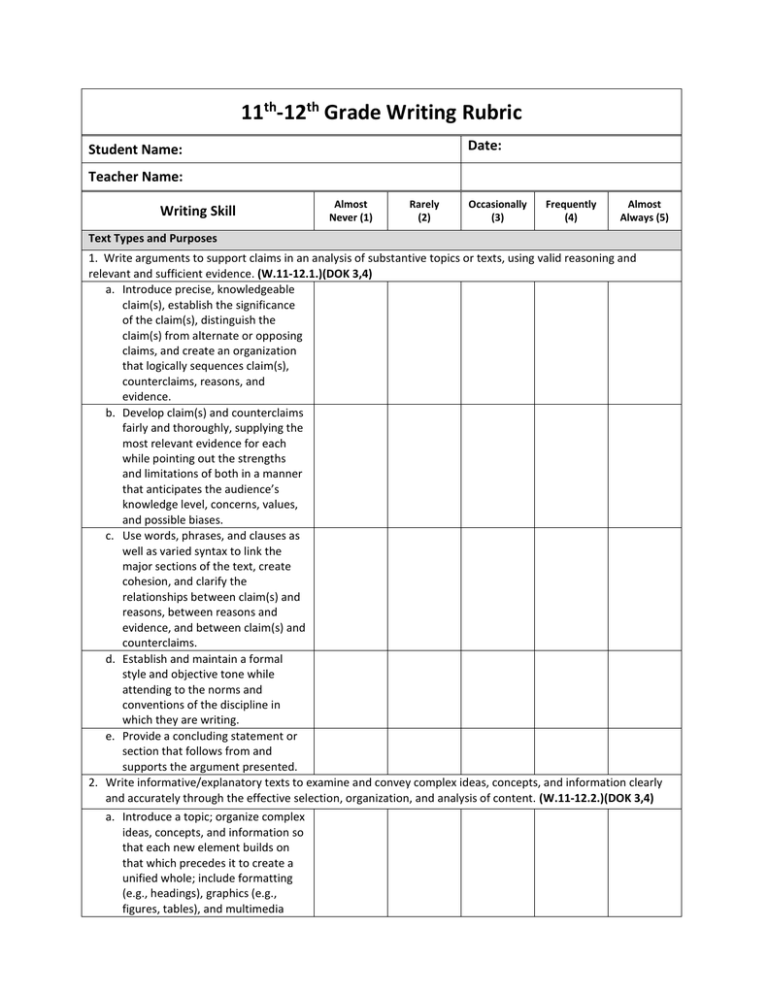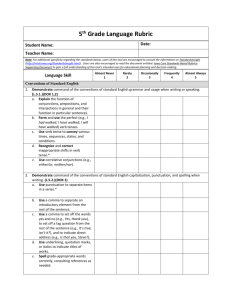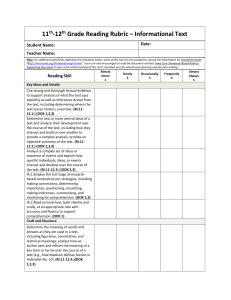11 -12 Grade Writing Rubric Date:
advertisement

11th-12th Grade Writing Rubric Date: Student Name: Teacher Name: Writing Skill Almost Never (1) Rarely (2) Occasionally (3) Frequently (4) Almost Always (5) Text Types and Purposes 1. Write arguments to support claims in an analysis of substantive topics or texts, using valid reasoning and relevant and sufficient evidence. (W.11-12.1.)(DOK 3,4) a. Introduce precise, knowledgeable claim(s), establish the significance of the claim(s), distinguish the claim(s) from alternate or opposing claims, and create an organization that logically sequences claim(s), counterclaims, reasons, and evidence. b. Develop claim(s) and counterclaims fairly and thoroughly, supplying the most relevant evidence for each while pointing out the strengths and limitations of both in a manner that anticipates the audience’s knowledge level, concerns, values, and possible biases. c. Use words, phrases, and clauses as well as varied syntax to link the major sections of the text, create cohesion, and clarify the relationships between claim(s) and reasons, between reasons and evidence, and between claim(s) and counterclaims. d. Establish and maintain a formal style and objective tone while attending to the norms and conventions of the discipline in which they are writing. e. Provide a concluding statement or section that follows from and supports the argument presented. 2. Write informative/explanatory texts to examine and convey complex ideas, concepts, and information clearly and accurately through the effective selection, organization, and analysis of content. (W.11-12.2.)(DOK 3,4) a. Introduce a topic; organize complex ideas, concepts, and information so that each new element builds on that which precedes it to create a unified whole; include formatting (e.g., headings), graphics (e.g., figures, tables), and multimedia when useful to aiding comprehension. b. Develop the topic thoroughly by selecting the most significant and relevant facts, extended definitions, concrete details, quotations, or other information and examples appropriate to the audience’s knowledge of the topic. c. Use appropriate and varied transitions and syntax to link the major sections of the text, create cohesion, and clarify the relationships among complex ideas and concepts. d. Use precise language, domainspecific vocabulary, and techniques such as metaphor, simile, and analogy to manage the complexity of the topic. e. Establish and maintain a formal style and objective tone while attending to the norms and conventions of the discipline in which they are writing. f. Provide a concluding statement or section that follows from and supports the information or explanation presented (e.g., articulating implications or the significance of the topic). 3. Write narratives to develop real or imagined experiences or events using effective technique, well-chosen details, and well-structured event sequences. (W.11-12.3.)(DOK 3,4) a. Engage and orient the reader by setting out a problem, situation, or observation and its significance, establishing one or multiple point(s) of view, and introducing a narrator and/or characters; create a smooth progression of experiences or events. b. Use narrative techniques, such as dialogue, pacing, description, reflection, and multiple plot lines, to develop experiences, events, and/or characters. c. Use a variety of techniques to sequence events so that they build on one another to create a coherent whole and build toward a particular tone and outcome (e.g., a sense of mystery, suspense, growth, or resolution). d. Use precise words and phrases, telling details, and sensory language to convey a vivid picture of the experiences, events, setting, and/or characters. e. Provide a conclusion that follows from and reflects on what is experienced, observed, or resolved over the course of the narrative. Production and Distribution of Writing 4. Produce clear and coherent writing in which the development, organization, and style are appropriate to task, purpose, and audience. (Grade-specific expectations for writing types are defined in standards 1–3 above.) (W.11-12.4.) (DOK 3,4) 5. Develop and strengthen writing as needed by planning, revising, editing, rewriting, or trying a new approach, focusing on addressing what is most significant for a specific purpose and audience. (Editing for conventions should demonstrate command of Language standards 1–3 up to and including grades 11–12.) (W.11-12.5.) (DOK 1,2,3,4) 6. Use technology, including the Internet, to produce, publish, and update individual or shared writing products in response to ongoing feedback, including new arguments or information. (W.11-12.6.)(DOK 1,2) Research to Build and Present Knowledge 7. Conduct short as well as more sustained research projects to answer a question (including a self-generated question) or solve a problem; narrow or broaden the inquiry when appropriate; synthesize multiple sources on the subject, demonstrating understanding of the subject under investigation. (W.11-12.7.)(DOK 2,3,4) 8. Gather relevant information from multiple authoritative print and digital sources, using advanced searches effectively; assess the strengths and limitations of each source in terms of the task, purpose, and audience; integrate information into the text selectively to maintain the flow of ideas, avoiding plagiarism and overreliance on any one source and following a standard format for citation. (W.11-12.8.)(DOK 1,2,3,4) 9. Draw evidence from literary or informational texts to support analysis, reflection, and research. (W.11-12.9.) (DOK 2,3,4) a. Apply grades 11-12 Reading standards to literature (e.g., “Demonstrate knowledge of eighteenth-, nineteenth- and earlytwentieth-century foundational works of American literature, including how two or more texts from the same period treat similar themes or topics”). b. Apply grade 11-12 Reading standards to literary nonfiction (e.g., "Delineate and evaluate the reasoning in seminal U.S. texts, including the application of constitutional principles and use of legal reasoning [e.g., in U.S. Supreme Court Case majority opinions and dissents] and the premises, purposes, and arguments in works of public advocacy [e.g., The Federalist, presidential addresses]”). Range of Writing 10. Write routinely over extended time frames (time for research, reflection, and revision) and shorter time frames (a single sitting or a day or two) for a range of tasks, purposes, and audiences. (W.11-12.10.)(DOK 1,2,3,4) *Rating Descriptors Operationally Defined: Almost Never – grade level standard/skill is demonstrated/observed very little or not at all (with appropriate accommodations) with no generalization of skill across days and novel tasks. Rarely – grade level standard/skill is demonstrated/observed infrequently (with appropriate accommodations) with little or no generalization of skill across days and novel tasks; teacher prompting does not always result in demonstration of skill. Occasionally – grade level standard/skill is demonstrated/observed periodically (with appropriate accommodations) with inconsistent generalization across days and novel tasks; teacher prompting is often necessary for skill to be generalized. Frequently – grade level standard/skill is demonstrated/observed often (with appropriate accommodations) with consistent generalization of skill across days and novel tasks; occasional teacher prompting is necessary for skill to be generalized. Almost Always – grade level standard/skill is demonstrated/observed most of the time (with appropriate accommodations) with consistent and independent generalization of skill across days and novel tasks. Place calendar date next to the numeral to signify date of data summary, and a listing of utilized data sources, summary and next steps in the appropriate spaces Baseline Data Sources Date #1: Data Sources: Date #2: Summary: Next Steps: Data Sources: Date #3: Summary: Next Steps: Data Sources: Date #4: Summary: Next Steps: Data Sources: Date #5: Summary: Next Steps: Data Sources: Date #6: Summary: Next Steps: Data Sources: Date #7: Summary: Next Steps: Data Sources: Date #8: Summary: Next Steps: Data Sources: Date #9: Summary: Next Steps: Data Sources: Date #10: Summary Next Steps: Data Sources: Date #11: Summary: Next Steps: Data Sources: Date #12: Summary: Next Steps: Data Sources: Date #13: Summary: Next Steps: Data Sources: Date #14: Summary: Next Steps: Data Sources: Date #15: Summary: Next Steps: Data Sources: Date #16: Summary: Next Steps: Data Sources: Date #17: Summary: Next Steps: Data Sources: Date #18: Summary: Next Steps:






